Richard Johansson
Benchmarking Debiasing Methods for LLM-based Parameter Estimates
Jun 11, 2025Abstract:Large language models (LLMs) offer an inexpensive yet powerful way to annotate text, but are often inconsistent when compared with experts. These errors can bias downstream estimates of population parameters such as regression coefficients and causal effects. To mitigate this bias, researchers have developed debiasing methods such as Design-based Supervised Learning (DSL) and Prediction-Powered Inference (PPI), which promise valid estimation by combining LLM annotations with a limited number of expensive expert annotations. Although these methods produce consistent estimates under theoretical assumptions, it is unknown how they compare in finite samples of sizes encountered in applied research. We make two contributions: First, we study how each method's performance scales with the number of expert annotations, highlighting regimes where LLM bias or limited expert labels significantly affect results. Second, we compare DSL and PPI across a range of tasks, finding that although both achieve low bias with large datasets, DSL often outperforms PPI on bias reduction and empirical efficiency, but its performance is less consistent across datasets. Our findings indicate that there is a bias-variance tradeoff at the level of debiasing methods, calling for more research on developing metrics for quantifying their efficiency in finite samples.
CUB: Benchmarking Context Utilisation Techniques for Language Models
May 22, 2025Abstract:Incorporating external knowledge is crucial for knowledge-intensive tasks, such as question answering and fact checking. However, language models (LMs) may ignore relevant information that contradicts outdated parametric memory or be distracted by irrelevant contexts. While many context utilisation manipulation techniques (CMTs) that encourage or suppress context utilisation have recently been proposed to alleviate these issues, few have seen systematic comparison. In this paper, we develop CUB (Context Utilisation Benchmark) to help practitioners within retrieval-augmented generation (RAG) identify the best CMT for their needs. CUB allows for rigorous testing on three distinct context types, observed to capture key challenges in realistic context utilisation scenarios. With this benchmark, we evaluate seven state-of-the-art methods, representative of the main categories of CMTs, across three diverse datasets and tasks, applied to nine LMs. Our results show that most of the existing CMTs struggle to handle the full set of types of contexts that may be encountered in real-world retrieval-augmented scenarios. Moreover, we find that many CMTs display an inflated performance on simple synthesised datasets, compared to more realistic datasets with naturally occurring samples. Altogether, our results show the need for holistic tests of CMTs and the development of CMTs that can handle multiple context types.
Language Model Re-rankers are Steered by Lexical Similarities
Feb 24, 2025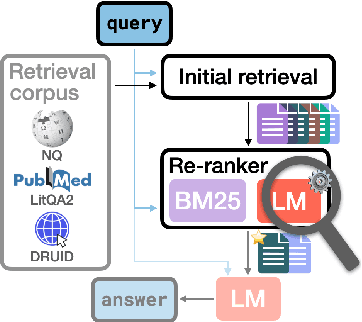
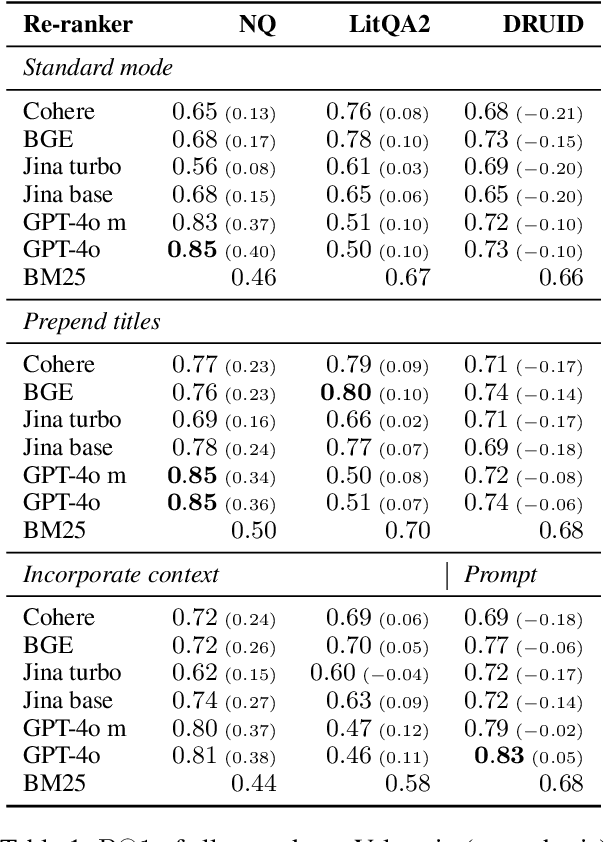
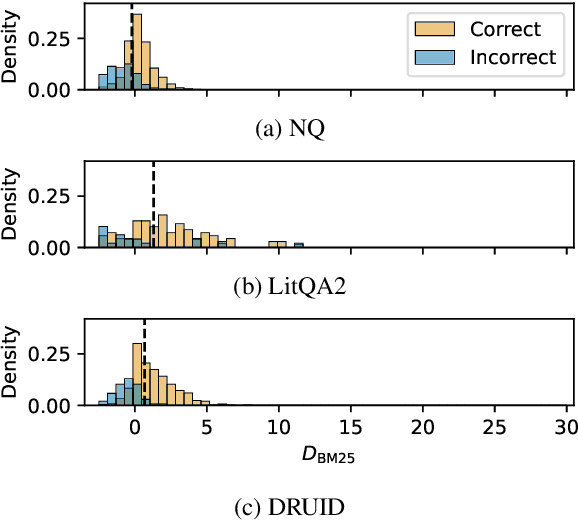
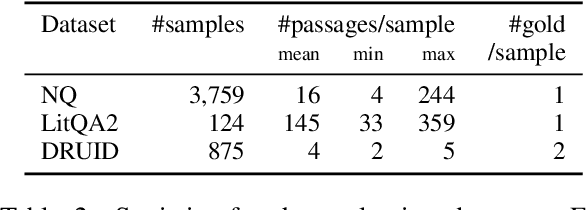
Abstract:Language model (LM) re-rankers are used to refine retrieval results for retrieval-augmented generation (RAG). They are more expensive than lexical matching methods like BM25 but assumed to better process semantic information. To understand whether LM re-rankers always live up to this assumption, we evaluate 6 different LM re-rankers on the NQ, LitQA2 and DRUID datasets. Our results show that LM re-rankers struggle to outperform a simple BM25 re-ranker on DRUID. Leveraging a novel separation metric based on BM25 scores, we explain and identify re-ranker errors stemming from lexical dissimilarities. We also investigate different methods to improve LM re-ranker performance and find these methods mainly useful for NQ. Taken together, our work identifies and explains weaknesses of LM re-rankers and points to the need for more adversarial and realistic datasets for their evaluation.
How Well Do Large Language Models Disambiguate Swedish Words?
Oct 30, 2024

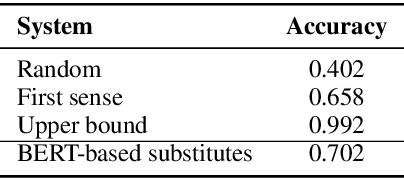

Abstract:We evaluate a battery of recent large language models on two benchmarks for word sense disambiguation in Swedish. At present, all current models are less accurate than the best supervised disambiguators in cases where a training set is available, but most models outperform graph-based unsupervised systems. Different prompting approaches are compared, with a focus on how to express the set of possible senses in a given context. The best accuracies are achieved when human-written definitions of the senses are included in the prompts.
Fact Recall, Heuristics or Pure Guesswork? Precise Interpretations of Language Models for Fact Completion
Oct 18, 2024Abstract:Previous interpretations of language models (LMs) miss important distinctions in how these models process factual information. For example, given the query "Astrid Lindgren was born in" with the corresponding completion "Sweden", no difference is made between whether the prediction was based on having the exact knowledge of the birthplace of the Swedish author or assuming that a person with a Swedish-sounding name was born in Sweden. In this paper, we investigate four different prediction scenarios for which the LM can be expected to show distinct behaviors. These scenarios correspond to different levels of model reliability and types of information being processed - some being less desirable for factual predictions. To facilitate precise interpretations of LMs for fact completion, we propose a model-specific recipe called PrISM for constructing datasets with examples of each scenario based on a set of diagnostic criteria. We apply a popular interpretability method, causal tracing (CT), to the four prediction scenarios and find that while CT produces different results for each scenario, aggregations over a set of mixed examples may only represent the results from the scenario with the strongest measured signal. In summary, we contribute tools for a more granular study of fact completion in language models and analyses that provide a more nuanced understanding of how LMs process fact-related queries.
Deciphering the Interplay of Parametric and Non-parametric Memory in Retrieval-augmented Language Models
Oct 07, 2024Abstract:Generative language models often struggle with specialized or less-discussed knowledge. A potential solution is found in Retrieval-Augmented Generation (RAG) models which act like retrieving information before generating responses. In this study, we explore how the \textsc{Atlas} approach, a RAG model, decides between what it already knows (parametric) and what it retrieves (non-parametric). We use causal mediation analysis and controlled experiments to examine how internal representations influence information processing. Our findings disentangle the effects of parametric knowledge and the retrieved context. They indicate that in cases where the model can choose between both types of information (parametric and non-parametric), it relies more on the context than the parametric knowledge. Furthermore, the analysis investigates the computations involved in \emph{how} the model uses the information from the context. We find that multiple mechanisms are active within the model and can be detected with mediation analysis: first, the decision of \emph{whether the context is relevant}, and second, how the encoder computes output representations to support copying when relevant.
Can Large Language Models (or Humans) Distill Text?
Mar 25, 2024Abstract:We investigate the potential of large language models (LLMs) to distill text: to remove the textual traces of an undesired forbidden variable. We employ a range of LLMs with varying architectures and training approaches to distill text by identifying and removing information about the target variable while preserving other relevant signals. Our findings shed light on the strengths and limitations of LLMs in addressing the distillation and provide insights into the strategies for leveraging these models in computational social science investigations involving text data. In particular, we show that in the strong test of removing sentiment, the statistical association between the processed text and sentiment is still clearly detectable to machine learning classifiers post-LLM-distillation. Furthermore, we find that human annotators also struggle to distill sentiment while preserving other semantic content. This suggests there may be limited separability between concept variables in some text contexts, highlighting limitations of methods relying on text-level transformations and also raising questions about the robustness of distillation methods that achieve statistical independence in representation space if this is difficult for human coders operating on raw text to attain.
What Happens to a Dataset Transformed by a Projection-based Concept Removal Method?
Mar 24, 2024



Abstract:We investigate the behavior of methods that use linear projections to remove information about a concept from a language representation, and we consider the question of what happens to a dataset transformed by such a method. A theoretical analysis and experiments on real-world and synthetic data show that these methods inject strong statistical dependencies into the transformed datasets. After applying such a method, the representation space is highly structured: in the transformed space, an instance tends to be located near instances of the opposite label. As a consequence, the original labeling can in some cases be reconstructed by applying an anti-clustering method.
The Effect of Scaling, Retrieval Augmentation and Form on the Factual Consistency of Language Models
Nov 02, 2023Abstract:Large Language Models (LLMs) make natural interfaces to factual knowledge, but their usefulness is limited by their tendency to deliver inconsistent answers to semantically equivalent questions. For example, a model might predict both "Anne Redpath passed away in Edinburgh." and "Anne Redpath's life ended in London." In this work, we identify potential causes of inconsistency and evaluate the effectiveness of two mitigation strategies: up-scaling and augmenting the LM with a retrieval corpus. Our results on the LLaMA and Atlas models show that both strategies reduce inconsistency while retrieval augmentation is considerably more efficient. We further consider and disentangle the consistency contributions of different components of Atlas. For all LMs evaluated we find that syntactical form and other evaluation task artifacts impact consistency. Taken together, our results provide a better understanding of the factors affecting the factual consistency of language models.
Surface-Based Retrieval Reduces Perplexity of Retrieval-Augmented Language Models
May 25, 2023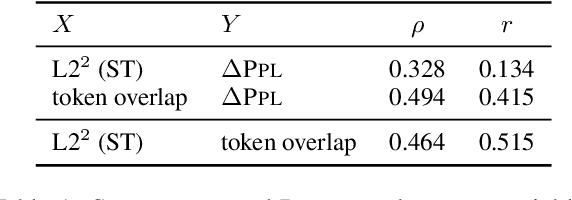
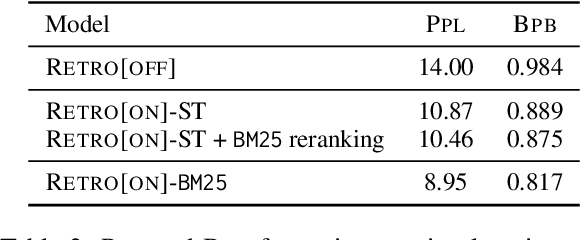
Abstract:Augmenting language models with a retrieval mechanism has been shown to significantly improve their performance while keeping the number of parameters low. Retrieval-augmented models commonly rely on a semantic retrieval mechanism based on the similarity between dense representations of the query chunk and potential neighbors. In this paper, we study the state-of-the-art Retro model and observe that its performance gain is better explained by surface-level similarities, such as token overlap. Inspired by this, we replace the semantic retrieval in Retro with a surface-level method based on BM25, obtaining a significant reduction in perplexity. As full BM25 retrieval can be computationally costly for large datasets, we also apply it in a re-ranking scenario, gaining part of the perplexity reduction with minimal computational overhead.
 Add to Chrome
Add to Chrome Add to Firefox
Add to Firefox Add to Edge
Add to Edge